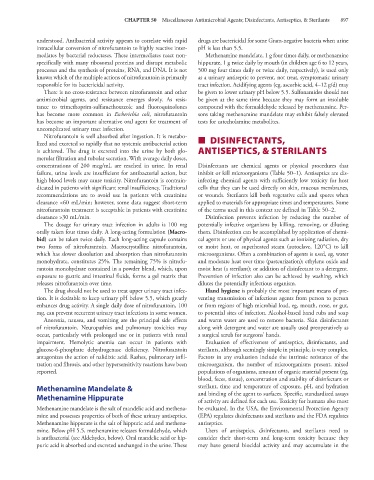Page 911 - Basic _ Clinical Pharmacology ( PDFDrive )
P. 911
CHAPTER 50 Miscellaneous Antimicrobial Agents; Disinfectants, Antiseptics, & Sterilants 897
understood. Antibacterial activity appears to correlate with rapid drugs are bactericidal for some Gram-negative bacteria when urine
intracellular conversion of nitrofurantoin to highly reactive inter- pH is less than 5.5.
mediates by bacterial reductases. These intermediates react non- Methenamine mandelate, 1 g four times daily, or methenamine
specifically with many ribosomal proteins and disrupt metabolic hippurate, 1 g twice daily by mouth (in children age 6 to 12 years,
processes and the synthesis of proteins, RNA, and DNA. It is not 500 mg four times daily or twice daily, respectively), is used only
known which of the multiple actions of nitrofurantoin is primarily as a urinary antiseptic to prevent, not treat, symptomatic urinary
responsible for its bactericidal activity. tract infection. Acidifying agents (eg, ascorbic acid, 4–12 g/d) may
There is no cross-resistance between nitrofurantoin and other be given to lower urinary pH below 5.5. Sulfonamides should not
antimicrobial agents, and resistance emerges slowly. As resis- be given at the same time because they may form an insoluble
tance to trimethoprim-sulfamethoxazole and fluoroquinolones compound with the formaldehyde released by methenamine. Per-
has become more common in Escherichia coli, nitrofurantoin sons taking methenamine mandelate may exhibit falsely elevated
has become an important alternative oral agent for treatment of tests for catecholamine metabolites.
uncomplicated urinary tract infection.
Nitrofurantoin is well absorbed after ingestion. It is metabo-
lized and excreted so rapidly that no systemic antibacterial action ■ DISINFECTANTS,
is achieved. The drug is excreted into the urine by both glo- ANTISEPTICS, & STERILANTS
merular filtration and tubular secretion. With average daily doses,
concentrations of 200 mcg/mL are reached in urine. In renal Disinfectants are chemical agents or physical procedures that
failure, urine levels are insufficient for antibacterial action, but inhibit or kill microorganisms (Table 50–1). Antiseptics are dis-
high blood levels may cause toxicity. Nitrofurantoin is contrain- infecting chemical agents with sufficiently low toxicity for host
dicated in patients with significant renal insufficiency. Traditional cells that they can be used directly on skin, mucous membranes,
recommendations are to avoid use in patients with creatinine or wounds. Sterilants kill both vegetative cells and spores when
clearance <60 mL/min; however, some data suggest short-term applied to materials for appropriate times and temperatures. Some
nitrofurantoin treatment is acceptable in patients with creatinine of the terms used in this context are defined in Table 50–2.
clearance >30 mL/min. Disinfection prevents infection by reducing the number of
The dosage for urinary tract infection in adults is 100 mg potentially infective organisms by killing, removing, or diluting
orally taken four times daily. A long-acting formulation (Macro- them. Disinfection can be accomplished by application of chemi-
bid) can be taken twice daily. Each long-acting capsule contains cal agents or use of physical agents such as ionizing radiation, dry
two forms of nitrofurantoin. Macrocrystalline nitrofurantoin, or moist heat, or superheated steam (autoclave, 120°C) to kill
which has slower dissolution and absorption than nitrofurantoin microorganisms. Often a combination of agents is used, eg, water
monohydrate, constitutes 25%. The remaining 75% is nitrofu- and moderate heat over time (pasteurization); ethylene oxide and
rantoin monohydrate contained in a powder blend, which, upon moist heat (a sterilant); or addition of disinfectant to a detergent.
exposure to gastric and intestinal fluids, forms a gel matrix that Prevention of infection also can be achieved by washing, which
releases nitrofurantoin over time. dilutes the potentially infectious organism.
The drug should not be used to treat upper urinary tract infec- Hand hygiene is probably the most important means of pre-
tion. It is desirable to keep urinary pH below 5.5, which greatly venting transmission of infectious agents from person to person
enhances drug activity. A single daily dose of nitrofurantoin, 100 or from regions of high microbial load, eg, mouth, nose, or gut,
mg, can prevent recurrent urinary tract infections in some women. to potential sites of infection. Alcohol-based hand rubs and soap
Anorexia, nausea, and vomiting are the principal side effects and warm water are used to remove bacteria. Skin disinfectants
of nitrofurantoin. Neuropathies and pulmonary toxicities may along with detergent and water are usually used preoperatively as
occur, particularly with prolonged use or in patients with renal a surgical scrub for surgeons’ hands.
impairment. Hemolytic anemia can occur in patients with Evaluation of effectiveness of antiseptics, disinfectants, and
glucose-6-phosphate dehydrogenase deficiency. Nitrofurantoin sterilants, although seemingly simple in principle, is very complex.
antagonizes the action of nalidixic acid. Rashes, pulmonary infil- Factors in any evaluation include the intrinsic resistance of the
tration and fibrosis, and other hypersensitivity reactions have been microorganism, the number of microorganisms present, mixed
reported. populations of organisms, amount of organic material present (eg,
blood, feces, tissue), concentration and stability of disinfectant or
Methenamine Mandelate & sterilant, time and temperature of exposure, pH, and hydration
Methenamine Hippurate and binding of the agent to surfaces. Specific, standardized assays
of activity are defined for each use. Toxicity for humans also must
Methenamine mandelate is the salt of mandelic acid and methena- be evaluated. In the USA, the Environmental Protection Agency
mine and possesses properties of both of these urinary antiseptics. (EPA) regulates disinfectants and sterilants and the FDA regulates
Methenamine hippurate is the salt of hippuric acid and methena- antiseptics.
mine. Below pH 5.5, methenamine releases formaldehyde, which Users of antiseptics, disinfectants, and sterilants need to
is antibacterial (see Aldehydes, below). Oral mandelic acid or hip- consider their short-term and long-term toxicity because they
puric acid is absorbed and excreted unchanged in the urine. These may have general biocidal activity and may accumulate in the

